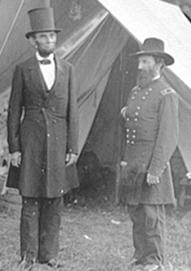
|
For the September
edition of
Historico
in PDF format,
click here. |
|
Have a Sangamon County history question? |
INDEX TO UPDATES
Hit the link or scroll down
-
SEPTEMBER 21 MEETING AT CLAYVILLE
Historical Archeologist to Speak
More About Clayville's History
Where and How to Learn More about this Historic Site
Bring a Collectible to Help Restoration -
PREVIEWING OCTOBER
Sign Up Now for Teas and Tours
Where's Rabbit Row? -
OTHER HISTORY EVENTS IN THE WORKS
Clayville Readies Fall Fest
Iles House Offers Series
History Conference Set
Reagan Country Tour Deadline
(posted August 26, 2010)
Fall Meeting Season Opener at Clayville
September 21 With
Tours, Optional Box Dinner, Talk by Historical Archeologist
The
Sangamon County Historical Society opens its fall monthly program season on
Tuesday, September 21, with a first-hand look at Clayville and its
remarkable---and ongoing rebirth—as an important historical attraction. 
Historical
archaeologist Annie Reiken (at right), who has been providing the
professional guidance for its renewal,
will be the evening’s speaker. Her topic will be “Stewardship.”
The presentation
begins at 7 p.m. Starting at 6 p.m., you’ll be able to take a self-guided tour
of the site plus enjoy a Carol Jean Fraase Fall-themed box dinner.
(You must pre-order the box dinner by September 19. See ordering information
below). The 7 p.m. program is free and open to the public.
Reiken has made
a career out of rescuing historic sites. A former nurse mid-wife, youth
counselor and school district wellness coordinator, she redirected her energies
toward a career in historic archeology and architectural history in 1990.
“Saving, recording, and on occasion, moving structures has been essential to my
life style for the past 20 years now,” she says.
Employed by SCI
Engineering, Inc., a St. Louis professional consulting engineering firm, she
also handles contract cultural resources survey work for major pipelines coming
through America from Canada. Her job has taken her across Indiana, Illinois,
Missouri, Kansas, Oklahoma, Nebraska and Montana.
“I believe in
life-long learning and am here to be a student and teacher when invited. I love
to help individual people or not-for-profit groups save money by utilizing my
background in preservation—both won and lost—on their own endeavors.
I believe that the best preservation is prevention, in people, structures
and social conditions.”
To reserve a box dinner, call
522-2500. The Fall-themed box dinner, which includes a drink, is priced at $15
per person. Your check, made payable to the Sangamon County Historical Society,
must be received by September 14. The box dinner will be $18 for reservations
made past that date through September 19. No reservations will be taken after
September 19. Mail checks to the Society at 308 East Adams Street, Springfield,
Illinois 62701 and be sure to include the names and e-mail addresses of any
guests. To download and print the PDF, click
here.
More About Clayville: Colorful Past Filled With Ups and Downs
Clayville was established by Moses Broadwell, a
Revolutionary War veteran from Elizabethtown, New Jersey who brought his family
to the area around 1820. He and his son John, a veteran of the War of 1812,
opened a tannery and built a brick kiln that allowed them to construct the first
brick house in Sangamon County. The Broadwells named the area Clayville in honor
of Henry Clay, a leading Whig politician.
Moses Broadwell
built the large brick inn in 1824 on what is now Route 125, just east of
Pleasant Plains. It became a popular stop through the 1850s for those traveling
between Springfield and Beardstown. Until railroads re-shaped transportation
patterns here, the Broadwell Tavern and Inn drew stage coach travelers, cattle
buyers from the East who spent the winter in Illinois while they bought up
livestock to ship the following spring; teamsters hauling dry goods, liquor,
groceries and more between the two cities; and families of settlers who spent
the night there before seeking property for themselves.
The original inn
was partially destroyed by fire in 1834, but was rebuilt by John Broadwell
within the year. (Moses Broadwell died in 1827). It is the oldest surviving
brick structure in Sangamon County.
In its heyday,
Clayville was the center of activities for the Whig Party. At one point, in
fact, the Broadwell Tavern was renamed Clay’s Ville and served as home to an
organization known as Clay’s Men, whose members included Abraham Lincoln.
Lincoln also became the lawyer for members of the Broadwell family, a
relationship that lasted for about 20 years.
Rescued From Oblivion
Eventually abandoned, Clayville was rescued from
historic oblivion in 1961 by Dr. Emmet F. Pearson, (right) a
Springfield physician with a deep commitment to local history. Dr. Pearson was a
founding member
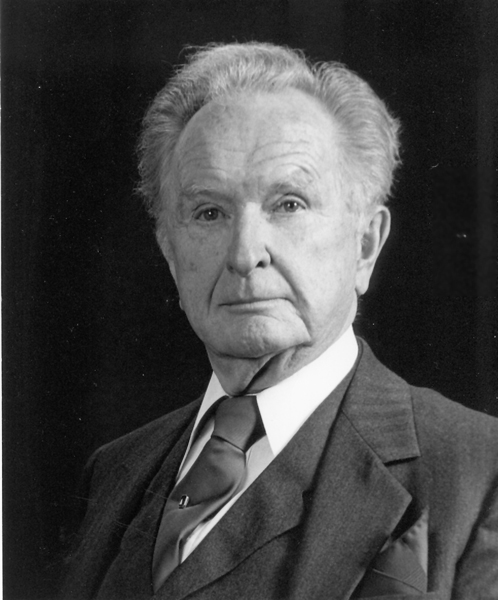 of
the Sangamon County Historical Society and served as president from 1966 to
1967. One of the Society’s first meetings during Dr. Pearson’s presidency , in
fact, was held at Clayville. At the
time of his death in 1996, Dr. Pearson, was a professor emeritus in the internal
medicine and medical humanities department at the Southern Illinois University
School of Medicine, Springfield. SIU’s Medical Museum is named in his honor as
well as its annual Medical History Lecture Series.
of
the Sangamon County Historical Society and served as president from 1966 to
1967. One of the Society’s first meetings during Dr. Pearson’s presidency , in
fact, was held at Clayville. At the
time of his death in 1996, Dr. Pearson, was a professor emeritus in the internal
medicine and medical humanities department at the Southern Illinois University
School of Medicine, Springfield. SIU’s Medical Museum is named in his honor as
well as its annual Medical History Lecture Series.
In an
interview conducted as part of a Sangamon State University oral history project
in 1972, Dr. Pearson recalled that he and his wife Mary were attracted to the
site after visiting many inns across the country and in Europe.
“We found this
building was architecturally as interesting as many we'd seen in other places.
It had wonderful woodwork, all walnut. Bricks were handmade on the grounds and
the other features of the building indicated it’s a very early type of
construction. We felt it was a must to restore it.”
“The
architecture of
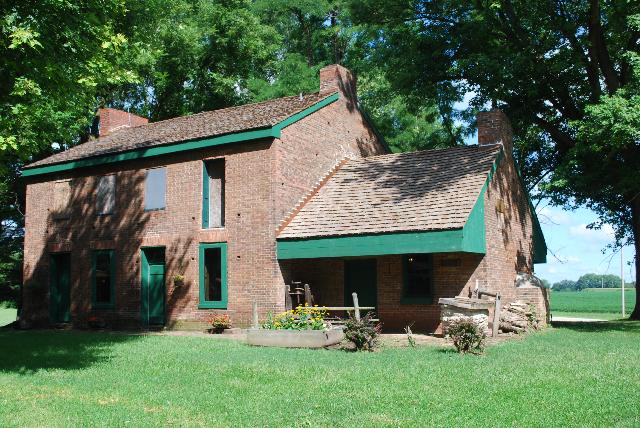 Clayville
is called Federal, which is a simple American style adapted to the frontier and
did not involve great skill, although the workmen of
Clayville must have been fairly skilled,” Dr. Pearson
observed. “The building looks very much like some
buildings we have seen in Pennsylvania.”
Clayville
is called Federal, which is a simple American style adapted to the frontier and
did not involve great skill, although the workmen of
Clayville must have been fairly skilled,” Dr. Pearson
observed. “The building looks very much like some
buildings we have seen in Pennsylvania.”
When Dr. Pearson
took title to the site in 1961, “great hand hewed exposed timbers” supported the
house and “all the mantles, doors, jams, and all of the woodwork” was solid
black walnut which is said to have been cut from walnut trees on the grounds. At
the time, the original hand-dug stone well was still in operation.
“The furniture
of the period for the inn came from houses and Sangamo Country,” he said, the
decorative arts representing the transitional period between the frugal cabins
of the frontier like New Salem and the more comfortable homes that were
developing in Springfield before the Civil War.
“Some of the
furniture was fairly good although much of it was primitive. Paintings of the
period were mostly done by itinerant or unskilled painters and artists. The
brick oven in the kitchen is the only brick oven we know west of the Allegheny
Mountains that still can be used to bake bread and other baked goods.”
Dr. Pearson put time
and money into the site, restoring its luster as a crossroads village by
replacing several outer buildings that had decayed and were torn down with other
authentic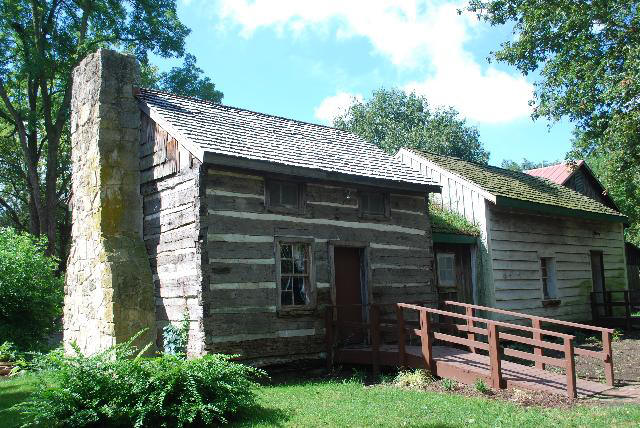 buildings. These included two log cabins that Dr. Pearson believed were built in
1817 and 1846 and two barns from the pre Civil-War period.
buildings. These included two log cabins that Dr. Pearson believed were built in
1817 and 1846 and two barns from the pre Civil-War period.
Members of the
Clayville Folk Arts Guild, of which Dr. Pearson was a member, soon filled the
site with local craftspeople that provided year around educational activities
designed to preserve knowledge of arts and crafts of early Illinois. Their
pottery, leather and knit goods and other handcrafts were sold at an on-site
crafts shop. A blacksmith, a country-kitchen educator, a summer theater-in-the
round, and a living “pioneer farm” to demonstrate farming methods before the
Industrial Revolution were also part of the operation as were annual spring and
fall arts festivals.
A Gift to Sangamon State
In 1973, Dr. Pearson donated the Clayville site to Sangamon State
University which operated it as a Rural Life Center and Museum until the early
90s. In addition to displays and interpretive programs that drew thousands of
school children and adults, the Center produced dozens of publications
reflecting research on post-pioneer rural life in the Midwest two decades before
the Civil War. Sangamon State, squeezed
for funds, closed The Rural Life Center and Museum 1992 when it said it could no
longer afford to fund it. The property was sold to Dave Bourland, curator of the
Illinois Executive Mansion.
In
ensuing years, the property fell into disrepair, weeds, brush and fallen trees
eventually blocking the site from public view, making it attractive to vagrants
and vandals. In 2007, the Broadwell Inn and Tavern was listed by Landmarks
Illinois as one of the state’s 10 most endangered historic places. At the time,
Landmarks Illinois noted that the building had become “open to the elements,
wildlife and vandals, and immediate intervention is needed to prevent further
structural damage.”
Saved by Community Action
That
intervention happened a few months later when a group of local residents formed
the Pleasant Plains Historical Society and led a community-wide effort to
purchase and restore the site. Their successful on-going clean-up (in which
volunteers recovered hundreds of antique items including blacksmith tools,
looms, and plows) as well as a fundraising campaign continues.
Several major
events have been held at the site and more are planned including a Fall Festival
on October 2 and 3 that is expected to draw several thousand visitors; a Haunted
House and Hayride on Friday and Saturday, October 22 and 23 and October 29 and
30 and on Sunday, October 31; and a “Clayville
Christmas” on December 11.
Today Landmarks Illinois lists the site as “saved."
|
To
Read More About Clayville, Turn
to the Web Although it ceased operations in 1992, the work of Sangamon State's Rural Life Center and Museum at Clayville lives on in actual and electronic archives around the country. Copies of publications produced by the Center can be viewed on line and downloaded at www.ideals.illinois.edu . They include “The Broadwells of Clayville and Their Roots," written by F. Kwedar and Kay MacLean and edited by Edward L. Hawes, A Sangamon State history professor who served as director of the Center from 1978 to 1980; "Clayville History: Tradition and Change in the Mid 19th Century” written by Hawes. They are also available on line from the University of Illinios Archives/Special Collections (www.uis/edu/achives) or from the Illinois Harvest (www.illinoisharvest.grainger.uiuc.edu), a resource arm of the University of Illinois at Urbana Champaign. A comprehensive history of the "Clayville Inn" written by Kay C. Watt that appeared in the Spring 1973 edition of the Journal of the Illinois State Historical Society can also be viewed on-line at www.jstor.org ). |
Bring a Collectible to Support Restoration Effort
Members of the Sangamon County
Historical Society can personally...and easily help with the
Clayv ille
restoration effort by donating a collectible that can be sold at
the Clayville Fall Festival to be held at the site on Saturday
October 2 and Sunday October 3.
ille
restoration effort by donating a collectible that can be sold at
the Clayville Fall Festival to be held at the site on Saturday
October 2 and Sunday October 3.
Proceeds from the "Treasure Flea Table of Collectibles"
will go to the Pleasant Plains Historical Society to further
their Clayville restoration work, says Bette Franke, who is
organizing the sale. Bring items to the Society’s September 21
meeting and you will receive a receipt for your tax records.
Donors should also include a written description of the item and
its estimated value.
|
Sign Up Now
Underway for Society's October Tours
FALL BUS TOUR
ALONG SUGAR
CREEK
(Sunday, October
17, 1 p.m.).
If you missed
the
.jpg) first tour in
June, you’ve
another
opportunity to
take a bus trip
back in time in
a tour of the
Cotton Hill
District,
Sangamon
County’s
birthplace. The
area—in and
around Sugar
Creek—was home
to the first
generation of
settlers here.
Traveling in a
comfortable, air
conditioned tour
bus, trip takers
will hear
stories and de
first tour in
June, you’ve
another
opportunity to
take a bus trip
back in time in
a tour of the
Cotton Hill
District,
Sangamon
County’s
birthplace. The
area—in and
around Sugar
Creek—was home
to the first
generation of
settlers here.
Traveling in a
comfortable, air
conditioned tour
bus, trip takers
will hear
stories and de.jpg) scriptions
of Sangamon’s
earliest
settlement sites
and view over
five 19th
century farm
houses and early
family
cemeteries. At
two of the
cemeteries,
actors will
portray several
of the early
settles buried
there. The
tour, expected
to take about
two-and-a half
hours, will
leave from the
Meijer’s parking
lot off Veterans
Parkway (Route
4), Springfield,
at 1 p.m. Sites
and history
along the route
will be detailed
by historian
Dick Hart. He’ll
do the same for
the north side
of Sugar Creek
on the way back.
Sign up early.
There are only
45 seats
available for
this trip.
Tickets are $40
for members, $50
for non-members. scriptions
of Sangamon’s
earliest
settlement sites
and view over
five 19th
century farm
houses and early
family
cemeteries. At
two of the
cemeteries,
actors will
portray several
of the early
settles buried
there. The
tour, expected
to take about
two-and-a half
hours, will
leave from the
Meijer’s parking
lot off Veterans
Parkway (Route
4), Springfield,
at 1 p.m. Sites
and history
along the route
will be detailed
by historian
Dick Hart. He’ll
do the same for
the north side
of Sugar Creek
on the way back.
Sign up early.
There are only
45 seats
available for
this trip.
Tickets are $40
for members, $50
for non-members. The Who, What, When, Where and Why of "Rabbit Row": October 19 You'll have to wait until October to learn more about this little know Springfield neighborhood that author Ken Mitchell will describe when he speaks to the Society at its monthly program meeting on Tuesday, October 19. The 7 p.m. session will be held at the Lincoln Public Library, 326 S. Seventh Street, Springfield. It promises to be a fascinating story, as Mitchell describes how this north end neighborhood got its name, how political and social divisions shaped its growth and what important piece of history was lost as outside forces moved to change the area's landscape. As usual, the meeting is open to the public, so bring along a friend or neighbor! |
|
|
Contact the Sangamon County Historical Society
Phone: 217-522-2500 Email:
schs@sancohis.org
All rights reserved. ©2010 Sangamon County Historical Society
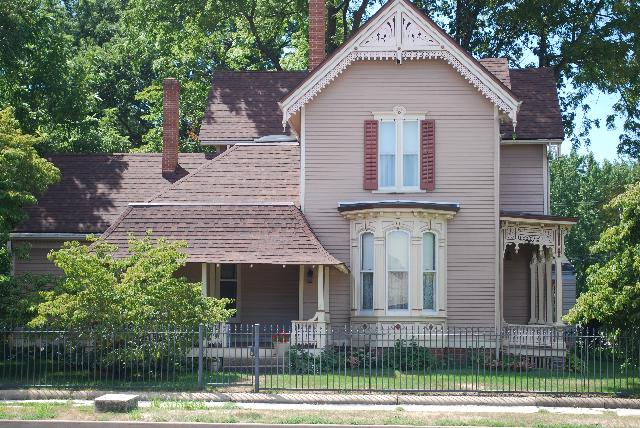 eventually passed to a
nephew, Arthur Freeman Hughes, whose widow sold the property to
Dr. and Mrs. Floyd Barringer. Passionate about local history,
the Barringers lovingly restored the Italianate-style home with
its intricate Carpenter-Gothic trim. The current owner, Mary Ann
Langston, has preserved its furnishings and antiques. At each
room, volunteer docents will point out features and answer
questions about specific features. Tea will be served. Each
session is limited to 25 participants. Tickets are $25 for
members, $30 for non members.
eventually passed to a
nephew, Arthur Freeman Hughes, whose widow sold the property to
Dr. and Mrs. Floyd Barringer. Passionate about local history,
the Barringers lovingly restored the Italianate-style home with
its intricate Carpenter-Gothic trim. The current owner, Mary Ann
Langston, has preserved its furnishings and antiques. At each
room, volunteer docents will point out features and answer
questions about specific features. Tea will be served. Each
session is limited to 25 participants. Tickets are $25 for
members, $30 for non members. guns and knives of the Old West and Civil War, and early 1800s reenactments including an old-fashioned “Revival Meeting” on Saturday after-noon in which real-life minister Ron Waltrip, pastor of Trinity Church of the Nazarene, will portray famed pioneer Methodist preacher and politician Reverend Peter Cartwright. In addition to his work as a traveling preacher, Cartwright was twice a member of the Illinois legislature and ran for Congress in 1846, only to be defeated by Springfield Whig Abraham Lincoln. Waltrip has performed with the Muni, the Jacksonville Theatre Guild and at New Salem. A clothesline art show, music by Mike Anderson, and a performance by Chris Camp, “The Whip Guy,” is also planned. The Clayville site will be the setting for Haunted House and Hayride Fridays and Saturdays, October 22 , 23, 29 and 30 and on Sunday, October 31 and “A Clayville Christmas” December 11. For more information, visit
guns and knives of the Old West and Civil War, and early 1800s reenactments including an old-fashioned “Revival Meeting” on Saturday after-noon in which real-life minister Ron Waltrip, pastor of Trinity Church of the Nazarene, will portray famed pioneer Methodist preacher and politician Reverend Peter Cartwright. In addition to his work as a traveling preacher, Cartwright was twice a member of the Illinois legislature and ran for Congress in 1846, only to be defeated by Springfield Whig Abraham Lincoln. Waltrip has performed with the Muni, the Jacksonville Theatre Guild and at New Salem. A clothesline art show, music by Mike Anderson, and a performance by Chris Camp, “The Whip Guy,” is also planned. The Clayville site will be the setting for Haunted House and Hayride Fridays and Saturdays, October 22 , 23, 29 and 30 and on Sunday, October 31 and “A Clayville Christmas” December 11. For more information, visit  by Richard E. Hart. It will be followed on September 29 with a talk on Donner Family History by Don Springer, a Donner descendent. Farrell Gay discusses the history of the Illinois Watch Company on October 6. Gay will display and discuss time pieces and watches from his personal collection. Reservations are required. Call 652-7302 for information.
by Richard E. Hart. It will be followed on September 29 with a talk on Donner Family History by Don Springer, a Donner descendent. Farrell Gay discusses the history of the Illinois Watch Company on October 6. Gay will display and discuss time pieces and watches from his personal collection. Reservations are required. Call 652-7302 for information. 